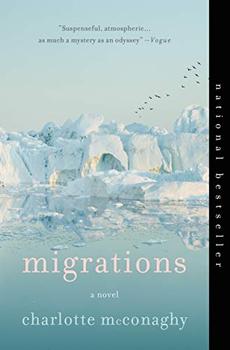Summary | Excerpt | Reading Guide | Discuss | Reviews | Beyond the Book | Read-Alikes | Genres & Themes | Author Bio

A Novel
by Charlotte McConaghyThis article relates to Migrations
 In Charlotte McConaghy's Migrations, Franny follows the migration of the Arctic tern (sterna paradisaea). McConaghy's novel is set in a fictional future in which the bird is on the brink of extinction. Currently, Arctic terns are not in danger to such a degree, as there are still more than one million of them around the world, but their habitats are threatened by climate change.
In Charlotte McConaghy's Migrations, Franny follows the migration of the Arctic tern (sterna paradisaea). McConaghy's novel is set in a fictional future in which the bird is on the brink of extinction. Currently, Arctic terns are not in danger to such a degree, as there are still more than one million of them around the world, but their habitats are threatened by climate change.
The Arctic tern is a small, grayish-white bird that ranges in length from about 11 to 15 inches, with a wingspan of between 25 and 30 inches. It holds the record for the longest observed migration journey of any bird; its yearly pattern runs from the Arctic to the Antarctic and back, covering a distance of at least 25,000 miles. Arctic terns breed in open, treeless areas, such as beaches and rocky islands. Their migration route, which takes them to Antarctica for the winter, brings some of the birds within close range of every continent.
Arctic terns are social, noisy birds who breed in colonies and subsist on a diet of small fish and insects. The birds often behave aggressively towards perceived outside threats, including humans. They pair off into monogamous couples for the breeding season and usually build their nests near water on rock or sand. Both parents incubate the eggs and take part in raising their young for about three months before they become independent. Arctic terns reach full maturity at the age of 3 or 4, and generally live between 20 and 30 years. It is estimated that the average Arctic tern travels close to 1.5 million miles in its lifetime, which is about the equivalent of three round-trip journeys to the moon.
Wildlife conservation organizations give different impressions of exactly to what degree the Arctic tern is currently endangered. The North American Waterbird Conservation Plan ranks it in their "High Concern" category, while the International Union for Conservation of Nature (IUCN) has placed it on their Red List of Threatened Species, but puts it in the category of "Least Concern" within this list. The organization Partners in Flight rates the bird's situation as being of moderate concern, and has not placed it on their Watch List of "Species of Concern." Part of the discrepancy may be due to the fact that Arctic terns' migration habits, which take them to remote areas, make tracking their populations difficult.
However, it is generally agreed that the species is under threat. The IUCN estimates that Arctic terns will lose 20–50% of their habitat due to climate change. The National Audubon Society, which includes an interactive map of North America on their web site showing projections of the birds' "range" (the amount of livable area available), estimates that an increase of 1.5oC will result in a 29% loss of range for the birds, while an increase of 3oC will result in as much as a 48% loss. This drastic reduction in habitable land due to what may seem like a relatively small increase in temperature emphasizes how urgent the climate situation is for the Arctic tern and many other species of wildlife.
An Arctic tern on a rock by Bothnian Bay in Simo, Finland
Filed under Nature and the Environment
![]() This "beyond the book article" relates to Migrations. It originally ran in September 2020 and has been updated for the
July 2021 paperback edition.
Go to magazine.
This "beyond the book article" relates to Migrations. It originally ran in September 2020 and has been updated for the
July 2021 paperback edition.
Go to magazine.
On the whole, human beings want to be good, but not too good and not quite all the time
Click Here to find out who said this, as well as discovering other famous literary quotes!
Your guide toexceptional books
BookBrowse seeks out and recommends the best in contemporary fiction and nonfiction—books that not only engage and entertain but also deepen our understanding of ourselves and the world around us.